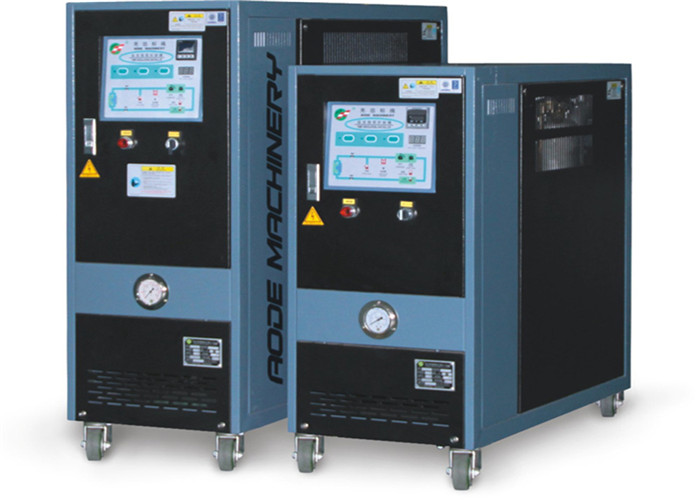Product Details
| Place of Origin: | Mold Controller Manufacturer |
|---|---|
| Brand Name: | AODE |
| Certification: | ISO, CE, ROHS |
| Model Number: | AODE- |
Payment & Shipping Terms
| Min Order: | 1 pc |
|---|---|
| Price: | $ |
| Packaging: | Protective/air bubble film, Wooden case. As client’s require |
| Delivery Time: | Within 20days after receiving |
| Payment Terms: | 30% T/T in advance, 70% balanc |
| Supply Ability: | 500pcs/month |
Detailed Product Description
Standard Oil Temperature Control Unit is a high-precision industrial thermal management system designed for stable temperature regulation from +45℃ to 180℃ using thermo-conductive oil. With PID ±1℃ accuracy, it ensures precise thermal control for plastic molding, die casting, chemical, and other heat-sensitive industries. Featuring customizable heating capacity, pump power, safety alarms, and RS485 connectivity, it improves production stability, energy efficiency, and automation integration.
The Standard Oil Temperature Control Unit operates by circulating heat-conducting oil through a closed-loop system to maintain a stable process temperature. First, the heater elevates the temperature of the thermal oil to the preset level (typically between 45°C and 180°C). The heated oil is then pumped to external equipment—such as molds, rollers, or reactors—transferring thermal energy for precise temperature regulation. A PID or PLC controller continuously monitors and adjusts the temperature by modulating the heating power and activating indirect cooling if necessary. Return oil temperature is displayed in real-time, and the system includes functions like automatic air exhaust, BY-PASS pressure relief, and safety alarms. This ensures stable heat transfer, energy efficiency, and reliable protection against overheating, oil starvation, or pump failure, making it ideal for plastics, rubber, die casting, and chemical industries.
|
|
ITEM | UNIT | Model | |||||
AOS-05(A) | AOS-10(A) | AOS-20 | AOS-30 | AOS-50 | AOSD-10 | ||
Temp control range | ℃ | Inlet water temperature +45℃-180℃ | |||||
Temp control accuracy | ℃ | PID±1℃ | |||||
Power supply | AC3∮380V 50Hz(3phase+Earth);AC3∮440V 60Hz;AC3∮460V 60Hz | ||||||
Heat transfer medium | Thermo conductive oil | ||||||
Cooling method | Indirect Cooling | ||||||
Heating capacity | KW | 6 | 9 | 9 | 18 | 24 | 9+9 |
Pump Horsepower | hp | 0.5 | 1 | 2 | 3 | 5 | 1+1 |
Pump flow | L/min | 30(22) | 85(30) | 120 | 150 | 240 | 85+85 |
Pump pressure | kg/cm² | 1.7(1.3) | 1.5(1.7) | 1.7 | 2 | 2.6 | 1.5 |
Max. power consumption | KW | 7 | 10 | 11 | 20.25 | 27.75 | 20 |
Alarm function | excess temperature/Open phase/oil starvation/ overloading/reverse turn | ||||||
Cooling water pipe | inch | 1/2 | 1/2 | 1/2 | 1/2 | 1/2 | - |
Circulating water pipe | inch | 3/8*2 | 3/8*4 | 3/8*4 | 1/2*4 | 3/4*4 | (3/8*4)*2 |
Size(L×W×H) | mm | 630*325*745 | 630*325*745 | 630*325*745 | 900*420*850 | 1400*500*1150 | 630*600*745 |
Weight | kg | 66 | 75 | 80 | 90 | 160 | 110 |
Remark: A. Volume of cooling water 20l/min(30℃.1kg/cm3), medium flow 50-100l/min B.Heating,cooling power or area ADDM-18/36 0.3㎡,ADDM-48/60 0.5㎡ C.About cold oil temperature is 200℃ D.The size of the equipment is only for reference,and the actual size of the equipment is accurate. | |||||||
|
|
Advantages
| Disadvantages
|
|
|
Heating Capacity – Customizable from 6KW to 36KW+ depending on process requirements.
Pump Horsepower & Flow Rate – Select from 0.5hp to 5hp with various flow and pressure configurations.
Temperature Range – Customize temperature control from +45°C up to 180°C (inlet water).
Control System – Choose between imported microcomputer or PLC control (e.g., Siemens/Delta).
Communication Protocols – Add RS485/Modbus communication for automation system integration.
Safety Enhancements – Optional explosion-proof design and auto air exhaust system.
Multi-point Control – Enable multiple temperature zones for complex industrial applications.
Electrical Brands – Option to choose preferred electrical components (ABB, Siemens, JUMO, WEST, etc.).
Cooling Features – Add instant cooling and oil shut-down functions for safety and process optimization.
Physical Design – Adjustable size and frame layout to fit factory space constraints.
Installation & Usage Guide
| Buying Advice
|

To operate the Standard Oil Temperature Control Unit, ensure proper pipe connections, fill thermal oil, power the unit, set the desired temperature on the PID or PLC controller, and monitor return oil temperature. Always follow the startup and shutdown instructions to avoid thermal shock.
The Standard Oil Temperature Control Unit offers precise PID control within a temperature range of +45°C to 180°C (for inlet water). It supports accurate process control with ±1°C deviation, ideal for applications like die casting, plastic molding, and chemical heating.
Yes, it offers multiple safety features such as over-temperature protection, oil starvation alarms, phase failure alerts, and optional explosion-proof design. Components from top brands (SIEMENS, ABB) ensure compliance with CE and other industrial certifications.
Always check oil level, avoid running dry, inspect power connections, and ensure the exhaust valve works correctly. Allow proper preheating and cooling cycles. Use protective gear and operate in a ventilated area to minimize fire or oil vapor hazards.
Pricing depends on heating capacity (6–36KW), pump power, control system (PLC vs. microcontroller), and optional functions like RS485, explosion-proof design, and multi-point temperature control. Custom-built models may vary in size and complexity.
Define your temperature range, heating speed, cooling method, pump capacity, and installation space. Also, assess the supplier’s after-sales service, component brands, safety features, and integration capabilities with your existing production systems.